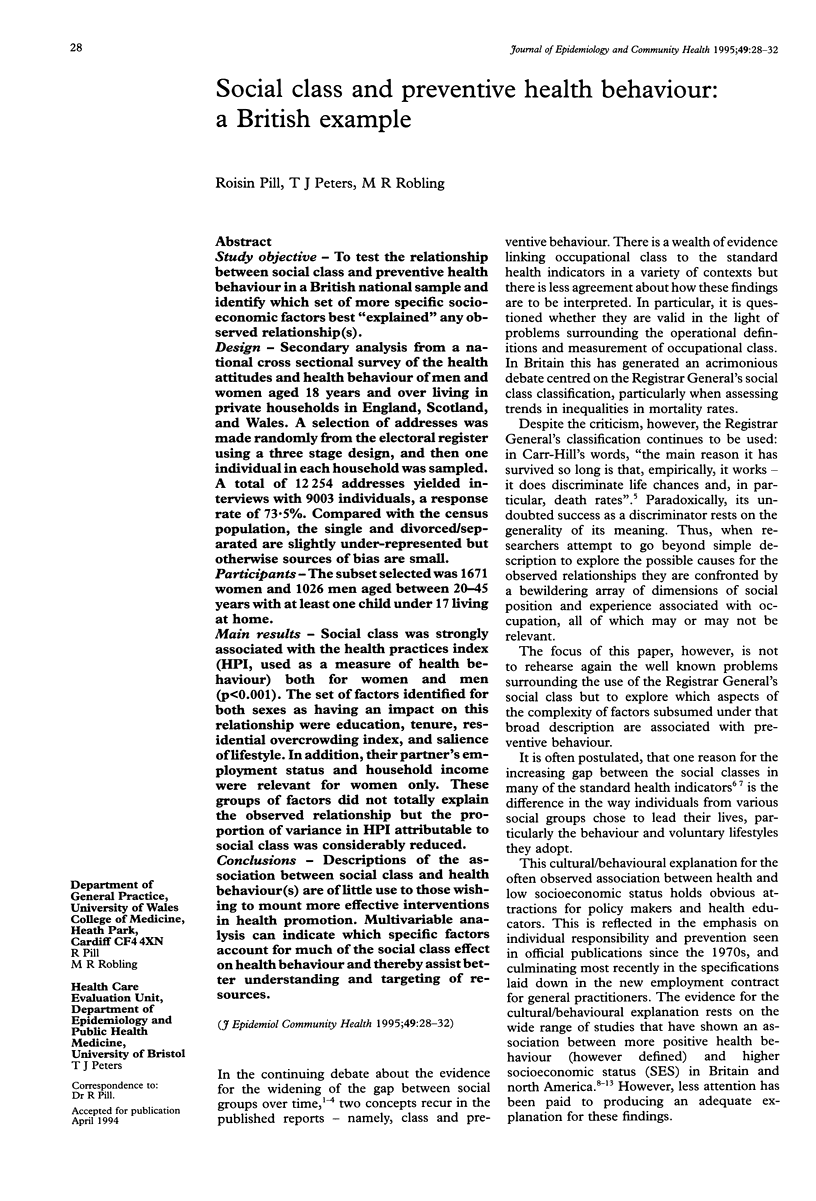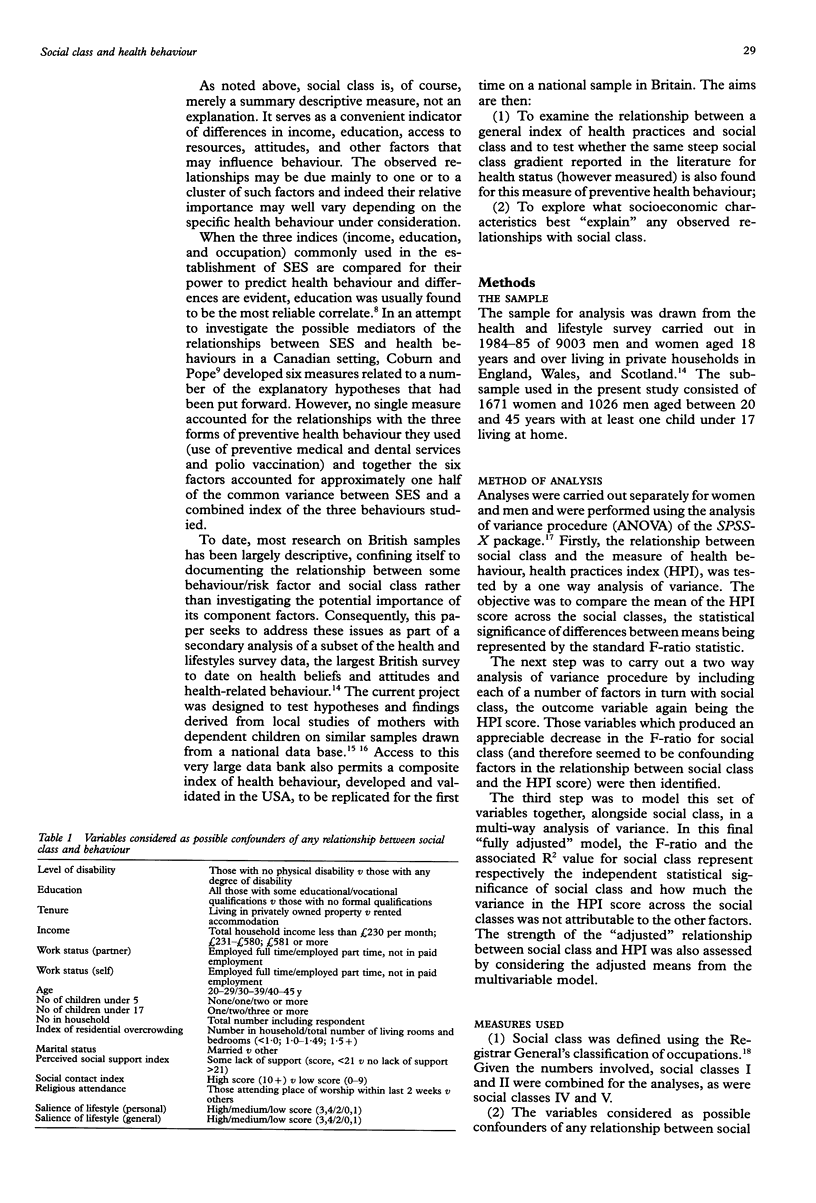Abstract
STUDY OBJECTIVE--To test the relationship between social class and preventive health behaviour in a British national sample and identify which set of more specific socioeconomic factors best "explained" any observed relationship(s). DESIGN--Secondary analysis from a national cross sectional survey of the health attitudes and health behaviour of men and women aged 18 years and over living in private households in England, Scotland, and Wales. A selection of addresses was made randomly from the electoral register using a three stage design, and then one individual in each household was sampled. A total of 12,254 addresses yielded interviews with 9003 individuals, a response rate of 73.5%. Compared with the census population, the single and divorced/separated are slightly under-represented but otherwise sources of bias are small. PARTICIPANTS--The subset selected was 1671 women and 1026 men aged between 20-45 years with at least one child under 17 living at home. MAIN RESULTS--Social class was strongly associated with the health practices index (HPI, used as a measure of health behaviour) both for women and men (p < 0.001). The set of factors identified for both sexes as having an impact on this relationship were education, tenure, residential overcrowding index, and salience of lifestyle. In addition, their partner's employment status and household income were relevant for women only. These groups of factors did not totally explain the observed relationship but the proportion of variance in HPI attributable to social class was considerably reduced. CONCLUSIONS--Descriptions of the association between social class and health behaviour(s) are of little use to those wishing to mount more effective interventions in health promotion. Multivariable analysis can indicate which specific factors account for much of the social class effect on health behaviour and thereby assist better understanding and targeting of resources.
Full text
PDF




Selected References
These references are in PubMed. This may not be the complete list of references from this article.
- Carr-Hill R. The measurement of inequities in health: lessons from the British experience. Soc Sci Med. 1990;31(3):393–404. doi: 10.1016/0277-9536(90)90286-2. [DOI] [PubMed] [Google Scholar]
- Coburn D., Pope C. R. Socioeconomic status and preventive health behavior. J Health Soc Behav. 1974 Jun;15(2):67–78. [PubMed] [Google Scholar]
- Davey Smith G., Egger M. Socioeconomic differentials in wealth and health. BMJ. 1993 Oct 30;307(6912):1085–1086. doi: 10.1136/bmj.307.6912.1085. [DOI] [PMC free article] [PubMed] [Google Scholar]
- Gottlieb N. H., Green L. W. Life events, social network, life-style, and health: an analysis of the 1979 National Survey of Personal Health Practices and Consequences. Health Educ Q. 1984 Spring;11(1):91–105. doi: 10.1177/109019818401100105. [DOI] [PubMed] [Google Scholar]
- Pamuk E. R. Social class inequality in mortality from 1921 to 1972 in England and Wales. Popul Stud (Camb) 1985 Mar;39(1):17–31. doi: 10.1080/0032472031000141256. [DOI] [PubMed] [Google Scholar]
- Pill R., Peters T. J., Robling M. R. Factors associated with health behaviour among mothers of lower socio-economic status: a British example. Soc Sci Med. 1993 May;36(9):1137–1144. doi: 10.1016/0277-9536(93)90233-t. [DOI] [PubMed] [Google Scholar]
- Pill R., Peters T. J., Robling M. R. How important is health behaviour to the health of mothers of lower socio-economic status? J Public Health Med. 1993 Mar;15(1):77–82. doi: 10.1093/oxfordjournals.pubmed.a042823. [DOI] [PubMed] [Google Scholar]
- Pill R., Stott N. C. Development of a measure of potential health behaviour: a salience of lifestyle index. Soc Sci Med. 1987;24(2):125–134. doi: 10.1016/0277-9536(87)90245-0. [DOI] [PubMed] [Google Scholar]
- Smith G. D., Bartley M., Blane D. The Black report on socioeconomic inequalities in health 10 years on. BMJ. 1990 Aug 18;301(6748):373–377. doi: 10.1136/bmj.301.6748.373. [DOI] [PMC free article] [PubMed] [Google Scholar]
- Steele J. L., McBroom W. H. Conceptual and empirical dimensions of health behavior. J Health Soc Behav. 1972 Dec;13(4):382–392. [PubMed] [Google Scholar]


